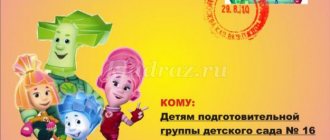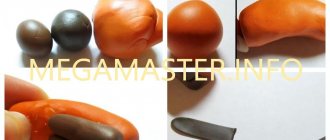Insects made of plasticine. Master class with step-by-step photos
Every insect is busy, wants its own good and life
Master Class. Modeling insects.
Author: Chepeleva Tatyana Aleksandrovna The material is intended for children of preschool and primary school age, teachers and educators.
Quite recently, on occasion, I purchased a bundle of soft, fluffy wire called “chenille”.
And they also gave me a whole package of paper-based film for laser printers (such as lamination film). So I started thinking, how to use this “wealth”? Materials: chenille, transparent paper-based film for laser printers, plasticine, toothpicks, CD marker, scissors.
Purpose: making plasticine crafts and toys. Objectives: Show the possibilities of new materials (chenille, transparent film) in modeling. Diversify the technique of working with non-traditional materials in modeling. Improve the skills of modeling, manual labor, and drawing. Clarify and enrich children's knowledge about insects; Form stable ideas about the color, shape, size of the insect proposed as a sample. Introduce children to poems, riddles, and sayings about insects. Develop eye, fine motor skills, speech, attention, thinking. Cultivate interest in the world of insects and nature. Vesna the artist (abbreviated) Vesna Krasna has begun work. She didn't get down to business right away. At first, I thought: what kind of picture should she draw? Here the forest stands in front of her - still gloomy and gloomy like winter. “Let me decorate it in my own way, in spring!” She took thin, delicate brushes. I touched the birch branches with a little greenery, and hung pink and silver earrings on the aspens and poplars. Day by day the picture of spring becomes more and more elegant. Everything comes alive all around. Sensing the warmth, insects and spiders crawl out of various cracks. May beetles buzzed near the birch branches. The first bees and butterflies fly to the flowers. And for each of them, Spring is Red, she came up with an important task. (Georgy Skrebitsky) Today we will sculpt insects. Which ones? Let's consider. No. 1 Dragonfly You see everything, dragonfly - your eyes are big! Your chirping flight is like a helicopter in the sky. During an “emergency” landing, you boldly put out your paws.
- Let's look at her body parts. How many are there, what do they look like?
1. We sculpt the same ones - head, torso, tail. 2. We connect them, for strength, using a toothpick and smearing. 3. Cut the chenille wire into equal parts, according to the number of legs. Draw wings on film. 4. Bend the wire for the legs and cut out the wings. 5. We connect all the parts. 6. Add eyes (ready). But my daughter doesn’t like them: “It doesn’t look like it!” 7. Add plasticine green balls - great eyes!
No. 2 Green beetle (unfortunately, I didn’t see the name) I’ll put the bug in my palm - let it sit there for a little while. Oh oh oh! How he tickles! He wants to get out quickly! (Svetlana Bogdan)
1. Consider a green beetle. 2. Roll 2 balls, a small one for the head, a larger one for the body. We select chenille. The green one is missing, take the blue one. 3. Flatten the ball for the body, forming a similarity. We string the head and body onto a toothpick. Bend the chenille into 6 equal parts and cut. 4. We bend the “legs” like a ladder and stick them into the body. Adding eyes. Ready!
No. 3 Spider – tarantula. There is a spider in the corner, It has woven both a house and a net. Now he’s resting, waiting for Mushka.
- We are considering. We count the number of legs, there are 8 of them. 2 more antennae.
1. Roll large, medium, small balls. 2. We put all 3 on a toothpick sequentially. 3. We cut the smallest one with a knife - we get eyes. 3. We measure, chenille into 8 equal legs and 2 small antennae, cut. 4. We stick the legs into the body. Wow, so similar! No. 4 Fly
An annoying fly. Yuri Entin
The annoying Kruzha Fly is buzzing in your ear. An annoying fly buzzes around your ear. Annoying Fly - No voice, no hearing. No voice, no hearing - Annoying Fly.
1. Daughter Yulia categorically does not want to sculpt a green fly. We agree that there are yellow ones too. We sculpt 3 balls - for the body, head, eyes. We select chenille. 2. Roll out the larger ball into a “dumbbell”, shape the ball-head like a barrel. Secure with a toothpick. Adding eyes. We cut the chenille and bend it. 3. On the film we draw wings as similar as possible. Let's cut them out. 4. We connect all the parts into a single fly.
When the modeling is finished, it is necessary to remember the story of Georgy Skrebitsky “Spring the Artist”. Ask the question: “What important thing did Vesna Krasna come up with for insects?” Let the guys think and express their assumptions.
We recommend watching:
Plasticineography in elementary school. Master class Plasticineography in elementary school Plasticineography in Khokhloma patterns. Bunch of rowan berries Plasticineography for junior schoolchildren Birch grove. Step-by-step instructions with photos
Similar articles:
Calla lilies made of plasticine
Summary of OOD on modeling for children of the junior group of the preschool educational institution "May Bug"
Summary of organized educational activities for children of the junior group “Chafer Bug”
Goal: continue to introduce children to different insects.
Program objectives: Educational: - introduce children to the “chafer bug”, consider what parts it consists of (head, torso, wings, paws, mustache, eyes); - consolidate sculpting techniques by pinching from a whole piece of plasticine and by pressing down the parts to connect; — consolidate the pronunciation of the sound [Zh]; — fix the score within five;
Developmental: - development of fine motor skills of the hands; - speech development; — development of the articulatory apparatus; - development of speech breathing;
Educational: - cultivate interest and curiosity for living nature.
Methods and techniques: verbal, game, visual, practical.
Material: picture - cockchafer, brown or burgundy, green and black plasticine (for eyes and mustache); toy May beetle or simple beetle, sound recording - buzzing sound.
Preliminary work: looking at insects while walking.
Progress: The teacher draws the children’s attention to the sound that is heard in their group. A recording of buzzing sounds. Educator: - Children, listen, I think I hear some sound. What could it be? Children: - It's buzzing, maybe it's a beetle.
The teacher takes out a toy beetle from under the table. The sound stops. Educator: - Hello, beetle - beetle, reddish tank. Was it you who was buzzing around us and scared all the guys? Children look at a beetle.
Also an interesting lesson in sculpting in ml. preschool educational institution group: Summary of a lesson on artistic creativity (modeling) in the second junior group of the kindergarten “Ladder for the little squirrel”
Educator: - Guys, in May a lot of insects appear, they come to life after hibernation. These are the beetles that are called May beetles. Let's look at the picture, tell me what the beetle has? Children: - Torso, wings, mustache, eyes, head, paws.
Educator: - What color is it? Children: - Red, brown.
Educator: - How many paws does a beetle have on each side? Children count. Children: - Three paws on each side.
The teacher draws the children's attention to special fluffy mustaches with tassels at the ends. Educator: - How many mustaches does the cockchafer have? Children: - A pair of mustaches.
Educator: - That's right, well done. Let's buzz like bugs. Articulation gymnastics “Beetles”. Children pronounce zhu - zhu - zhu by stretching their lips forward in a tube.
Educator: - Suddenly a light breeze blew on a spring flower. Breathing exercise, children blow on their palm.
Educator: - Children, and also beetles, can fly from one plant to another. Let's play the game "Bugs for a Walk." Outdoor game “Beetles for a walk.” The teacher divides the territory on the carpet with a jump rope or ribbon, crawl on one side, and fly on the other side. At the command of an adult - “On the flower”, children begin to crawl on all fours; at the signal - “Let’s fly”, children jump over the tape and “fly” on the other side of the carpet.
Educator: - Guys, it’s a pity that the cockchafer is not so often found in the city. Or maybe we’ll make our own cockchafers from plasticine? Children: - Yes!
The children sit at the tables. Perform finger gymnastics “Beetles”. Moving your fingers across the table “like bugs.” They knead the plasticine, make a body, and use the technique of pinching the head and pressing to attach the paws, whiskers, and eyes. Draw a line of wings on the back in a stack. The teacher helps by individually showing modeling techniques.
Educator: - Well done! You made some excellent cockchafers.
Result: Children look at their plasticine cockchafers and play out any plot.
Title: Abstract of educational activities on modeling for children of the junior group of the preschool educational institution "May Bug" Nomination: Kindergarten, Lesson notes, GCD, modeling, applique, junior group Author: Bolkunova Valentina Vladimirovna Position: teacher Place of work: MBDOU No. 81 "Kindergarten" Location : Kemerovo, Kemerovo region
Date modified: 05/13/2016



